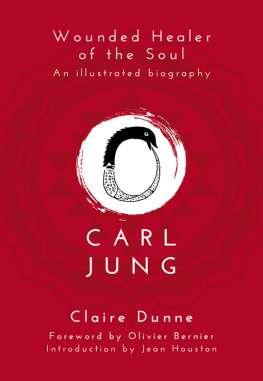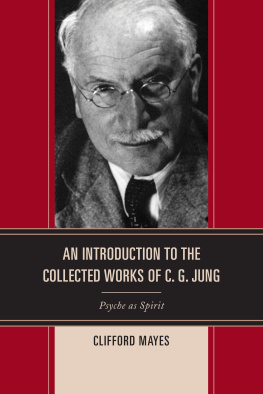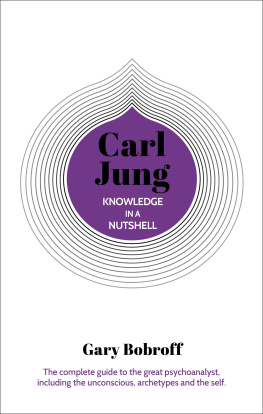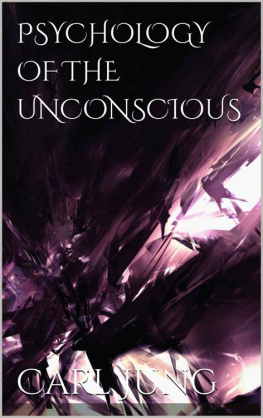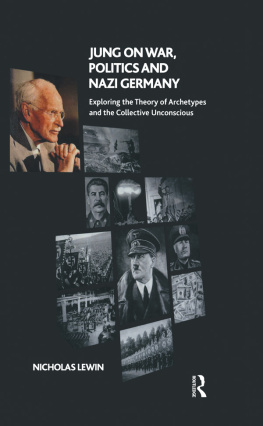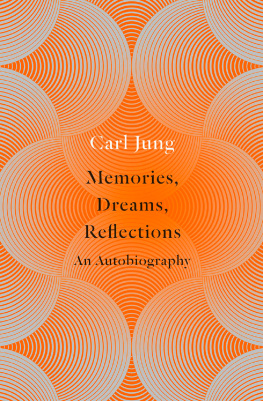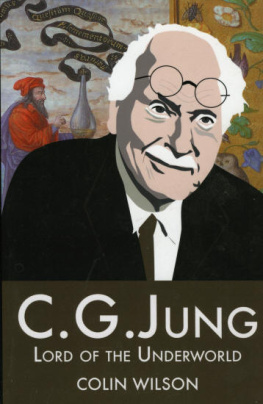CARL JUNG
Wounded Healer of the Soul

CARL JUNG
Wounded Healer of the Soul
Claire Dunne

Published in association with the
Shelley & Donald Rubin Foundation, New York
Carl Jung Wounded Healer of the Soul
Claire Dunne
This edition first published in the UK and USA in 2015,
in association with the Shelley Donald Rubin Foundation, New York,
by Watkins, an imprint of Watkins Media Limited,
19 Cecil Court
London WC2N 4EZ
First published in 2000 by Parabola Books, USA
Copyright Watkins Media Limited 2012, 2015
Text copyright Claire Dunne 2000, 2012, 2015
Foreword copyright Olivier Bernier 2012, 2015
Introduction copyright Jean Houston 2000, 2012, 2015
For copyright of photographs and text extracts see pages which are to be regardedas an extension of this copyright.
The right of Claire Dunne to be identified as the Author of this text has been asserted in accordance with the Copyright, Designs and Patents Act of 1988.
All rights reserved. No part of this book may be reproduced in any form or by any electronic or mechanical means, including information storage and retrieval systems, without permission in writing from the publisher, except by a reviewer who may quote brief passages in a review.
Managing Editor: Sandra Rigby
Senior Editor: Fiona Robertson
Designers: Studio 31, Luana Gobbo, Gail Jones
Picture Research: Miriam Faugno and Emma Copestake
Production: Uzma Taj
A CIP record for this book is available from the British Library
ISBN: 978-1-78028-831-4
10 9 8 7 6 5 4 3 2 1
Typeset in Gill Sans
Colour reproduction by XY Digital Limited
Printed in China
www.watkinspublishing.com
The Alchemist; manuscript page from Salomon Trismosin, Splendor Solis, 1582.
Watkins gratefully acknowledges the financial support of the Shelley & Donald Rubin Foundation, New York, in making possible the publication of this new edition of Carl Jung Wounded Healer of the Soul. Claire Dunnes outstanding contribution to Jungian scholarship has been widely acclaimed by both academics and professionals, and continues to educate and inform a wider readership. The book derives its authority from a unique combination of primary source material, inspirational artworks and the authors compelling insight and analysis.
CONTENTS
FOREWORD
C.G. JUNG: UNDERSTANDING THE WORLD
Inside and outside, the psyche and the world: when C.G. Jung explored the first, he also provided us with a new understanding of the other. We read Jung, discover the collective unconscious, and become aware of our shared humanity; we understand the elements of our personality and begin to see why we and others behave as we do. We read the account of Jungs own tortured journey in The Red Book, and it becomes frighteningly clear that there is no personal growth without suffering, and that there can be no progress without personal growth.
For a while, in the 1970s and 80s, Jung was fashionable in the United States. His categories became buzzwords, and thus, too often, easy and fallacious explanations; but, at least, many people felt the need to look in and reach a new depth of understanding. That has changed; a new, mechanistic kind of behaviorism is now the fashion; analysis is held to be too slow, too expensive, too inconvenient. A quick, easy, and cheap modification is thought best; and the result is a proliferation of often violent reactions which are neither understood nor really felt a sense that we live in an uncontrollable and often painful world.
We have indeed followed a curious path. The great thinkers of the Enlightenment rejected the trammels of the theologians. As they removed the endless prohibitions of traditional religions, they viewed the world in the bright light of Reason, and Science prospered. A century later, Freud officialized the existence of the unconscious, and its crucial importance in determining our feelings and our behavior; but his view was finally too reductionist. It was left for Jung to bring together culture and the unconscious, history and the archetypes; and as he did so, he provided us with the key to many mysteries and also with a way to improve ourselves, or, more exactly, to resist unpleasant manifestations of our repressions by becoming who we really are.
Tragically, not enough people, these days, read Jung, but Claire Dunnes Carl Jung Wounded Healer of the Soul may attract some converts. Admittedly, the sight of Jungs collected works can be daunting; nor is every one of his books readily accessible to the uninitiated. Even so, there is plenty we can read, and knowing about Jungs own journey is a perfect introduction. It is not just that we sympathize and wish him success: his struggle awakens in us curiosity and emulation. We may not wish to suffer as he did, but then we dont have to: we can enjoy the fruit of his labors, learn from his discoveries, and turn it all to our own psychological profit. To understand ourselves better is, of course, deeply rewarding, but there is more: those buried, unhealed wounds can now be seen, treated, and finally made harmless. And then comes the final step toward individuation: the discovery of who we really are, the opening of all those possibilities which exist because we are, finally, in touch with our talents and ourselves.
The drama and eloquence of Carl Jung Wounded Healer of the Soul would be enough to make us want to read it, but it is not just an account of the life of a great man. As Dunne tells us about Jung, she also tells us about analytical psychology; in fact, she offers us just the introduction into the world of Jung most likely to make us want to learn more. And that is the first step to seeing through the many illusions that cause deep and lasting unhappiness.
Understanding ourselves is also a tool for understanding the world. Aberrant, even destructive behavior on the part of nations and their leaders can often be understood in terms of psychology: if they are in the grip of an archetype, they are likely to forge blindly and destructively ahead and if we understand that, we are better able to deal with them. And then there is history. What was confusing or obscure becomes clear, just as what was opaque in ourselves is now transparent. We leave a world of dark, incomprehensible mysteries for a transparent, accessible, comprehensible universe; and that releases our creative potential even as it provides the deep satisfaction we experience when we finally understand.
Claire Dunne is thus doing us an enormous favor. By introducing us to Jung and to his Weltanschauung, she provides a necessary impetus. After reading Carl Jung Wounded Healer of the Soul, many will feel the need to move on to Jungs own books. As light begins to dawn, as we begin to see, to understand, to yearn for more clarity, we are also on the way to that magic formula that transmutes lead to gold.
OLIVIER BERNIER
PREFACE TO THE NEW EDITION
This book tells the story of the evolving personal and spiritual journey of Carl Gustav Jung, whose psychological legacy is still coming into its own as a profound influence on the world.
In 1913, Jung, then a prominent international figure in the newly formed psychiatric field, underwent a psychic death and rebirth, out of which emerged his own psychology. It was the major journey of his life.
Jungs The Red Book, containing his record of this inner process as it happened, was released for publication in 2009 after decades of speculation as to its contents.
Next page
